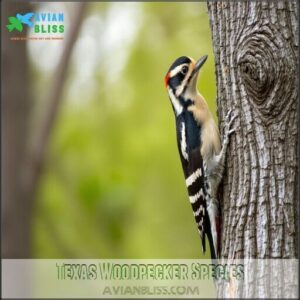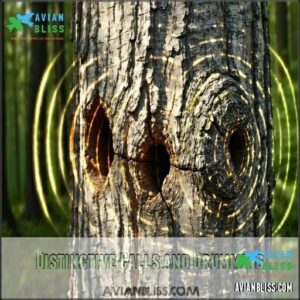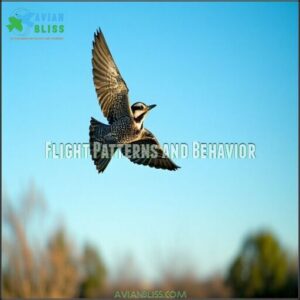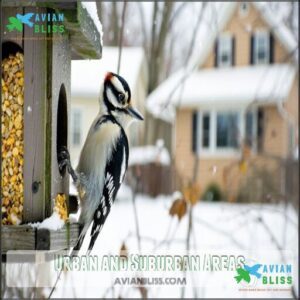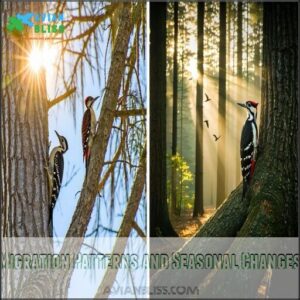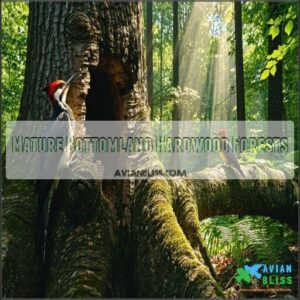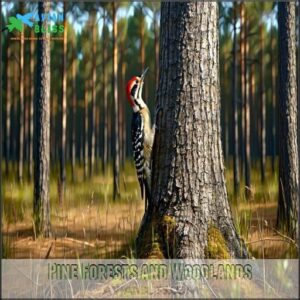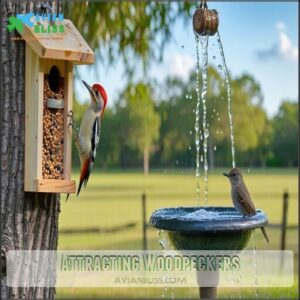This site is supported by our readers. We may earn a commission, at no cost to you, if you purchase through links.
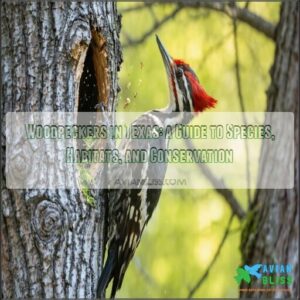
You’ll spot the Red-headed Woodpecker with its crimson crown or hear the Hairy Woodpecker’s sharp calls echoing through wooded areas.
These birds are nature’s pest controllers, feasting on insects, and their drumming creates nesting spots for other wildlife.
Look for them in pine forests, oak woodlands, and even urban parks.
Curious about attracting them? Think suet feeders, fruit, and old trees.
There’s more to explore about their habitats and behavior that might surprise you, especially their role in creating nesting spots.
Table Of Contents
- Key Takeaways
- Texas Woodpecker Species
- Woodpecker Identification
- Woodpecker Habitats
- Attracting Woodpeckers
- Woodpecker Conservation
- Frequently Asked Questions (FAQs)
- Is it good to have woodpeckers in your yard?
- What do woodpeckers in Texas look like?
- What attracts woodpeckers to your house?
- Why are woodpeckers pecking on the side of my house?
- What is the most common woodpecker in Texas?
- What is the difference between a black backed woodpecker and a hairy woodpecker?
- What kind of woodpeckers do we have in Texas?
- What attracts woodpeckers to my house?
- What types of woodpeckers are in Texas?
- How do woodpeckers communicate with each other?
- Conclusion
Key Takeaways
- You’ll find 16 types of woodpeckers in Texas, ranging from the tiny Downy Woodpecker to the crow-sized Pileated, each adapted to diverse habitats like forests, parks, and urban areas.
- They play a critical role in pest control, forest health, and creating nesting cavities used by over 40 other species.
- Attract them to your yard with suet feeders, fruit, native plants, and dead trees while providing water sources for year-round visits.
- Woodpeckers use drumming and calls to communicate, mark territories, and forage; their behavior helps you identify different species easily.
Texas Woodpecker Species
Texas is home to an impressive variety of woodpeckers, with species ranging from the tiny Downy Woodpecker to the striking Pileated Woodpecker.
From sparrow-sized Downy to crow-sized Pileated, Texas woodpeckers dazzle with their size, markings, and amazing drumming rhythms.
Each species has unique features and behaviors that reflect its adaptation to the state’s diverse habitats.
Hairy Woodpecker Characteristics
The Hairy Woodpecker, robin-sized, stands out among Texas woodpeckers for its striking black-and-white plumage.
Key features include:
- Size Comparison: Larger than the Downy Woodpecker.
- Plumage Details: Bold white back stripe.
- Bill Length: Long, chisel-like bill for drilling.
- Habitat Adaptations: Versatile, thriving in forests and urban areas.
- Foraging Behavior: Expert insect hunter, often scaling tree trunks.
Effortless woodpecker identification!
Downy Woodpecker Traits
Unlike its larger Hairy counterpart, the Downy Woodpecker is sparrow-sized, making it the smallest among Texas woodpeckers.
Its short bill and striking black-and-white plumage simplify woodpecker identification.
Known for its habitat adaptability, you’ll often spot it in wooded areas or even city parks.
Its foraging behavior includes pecking for insects in trees, showcasing its role in controlling Texas birds’ pest populations.
Red-cockaded Woodpecker Habits
The Red-cockaded Woodpecker, an endangered species in Texas, thrives in Pineywoods habitats, nesting exclusively in living pines softened by red heart fungus.
They’re experts in cavity excavation, carving out homes protected by resin wells that act as snake deterrents.
Known for cooperative breeding, family groups jointly raise young and forage together, showcasing a strong, social bond.
These birds face threats from habitat loss, but restoration efforts have bolstered populations.
Pileated Woodpecker Overview
The mighty Pileated Woodpecker towers as Texas’s largest woodpecker species, crow-sized at 16½ inches with distinctive red crest and white neck stripes.
You’ll recognize its deep, rectangular excavations in trees while searching for carpenter ants.
| Feature | Description | Texas Notes |
|---|---|---|
| Habitat Preference | Mature forests | Common in East Texas |
| Diet Details | Carpenter ants, beetles | Forages on fallen logs |
| Territory Defense | Year-round resident | Defends 150-200 acres |
The Pileated Woodpecker is a year-round resident that defends 150-200 acres, making it a notable species in Texas’s ecosystem.
Red-headed Woodpecker Identification
While the Pileated may be our largest woodpecker, the Red-headed Woodpecker stands out as Texas’s most striking species.
You’ll immediately recognize adult plumage by its brilliant crimson head contrasting sharply with crisp black and white body patterns.
Unlike other woodpecker species with partial red markings, this bird sports a completely red head. Juvenile markings appear more brownish-gray before molting patterns reveal their iconic coloration.
Watch for regional variations in size across different Texas habitats.
Woodpecker Identification
You’ll learn to identify Texas woodpeckers through their distinctive size, markings, and behaviors including bill shape and drumming patterns.
Understanding these characteristics helps you distinguish between similar species like the tiny Downy and the larger Hairy Woodpecker.
The striking red head and black-and-white pattern of the Pileated Woodpecker can also be recognized through these characteristics.
Visual Identification Features
To identify Texas woodpeckers, focus on their distinctive plumage details.
The Hairy and Downy share similar patterns but differ dramatically in size comparison and bill proportions.
Look for crest variations – Pileated’s vibrant red crest is unmistakable.
Note rump patches: Northern Flickers flash white rumps during flight.
Bill markings offer clues too – ivory-colored bills (historically) versus dark bills.
Golden-fronted Woodpeckers display striking yellow-orange nape patches that separate them from their Red-bellied cousins.
Distinctive Calls and Drumming
Have you ever wondered how to identify Texas woodpeckers when you can’t see them?
Drumming patterns and calls are species-specific sounds that serve as unique fingerprints.
Territorial drumming varies in frequency and rhythm—Pileated woodpeckers produce slow, resonant drumming while Downy woodpeckers create rapid, light sequences.
Call variation ranges from the Northern Flicker’s loud "wicka-wicka" to the Red-bellied’s rolling "churr".
These communication methods help identify woodpecker species throughout Texas.
Flight Patterns and Behavior
Through the air, Texas woodpeckers display a distinctive undulating flight pattern—flapping several times then briefly folding their wings in a roller-coaster motion.
You’ll notice their flight speed varies by species; Pileated woodpeckers maintain strong, direct paths while distinguishing themselves from crows.
Unlike birds with soaring ability, woodpeckers rarely exhibit flocking behavior. Watch for their agility maneuvers when moving between trees, often landing vertically with impressive takeoff techniques.
Bill Shape and Size
Looking at a woodpecker’s bill shape and size provides instant clues to its identity and foraging efficiency.
In Texas woodpecker species, bill length varies dramatically – from the Downy’s short, delicate bill to the Pileated’s powerful chisel.
This variation in bird morphology reflects each species’ excavation power and ecological niche. The Hairy Woodpecker’s longer bill distinguishes it from the similar-looking Downy, while the Red-bellied’s sturdy bill evolution supports its diverse foraging habits.
Plumage Color and Pattern
While bill features help identify woodpeckers, plumage color and pattern provide instant visual clues.
Texas woodpeckers display distinctive markings that vary by species, gender, and age.
Three key plumage identifiers include:
- Red markings (typically on males)
- Black and white patterns (varies by species)
- Unique features like the Golden-fronted Woodpecker’s yellow nape
Hybrid identification becomes challenging where ranges overlap, such as Golden-fronted and Red-bellied woodpeckers in central Texas, where aberrant coloration may appear.
Woodpecker Habitats
You’ll find Texas woodpeckers thriving in diverse environments across the state, from mature bottomland hardwood forests in the east to pine woodlands and even urban parks.
Whether you’re exploring the extensive forests preferred by Pileated Woodpeckers or observing Red-bellied Woodpeckers in suburban settings, these adaptable birds establish territories based on available food sources and suitable nesting sites, which is a key factor in their ability to thrive in urban parks.
Forest Types and Regions
Texas’s diverse forests create a woodpecker paradise across distinct geographical regions.
You’ll find eight woodpecker species in the eastern Pineywoods habitat, where mature pines support endangered red-cockaded woodpeckers.
Oak woodlands throughout central Texas attract golden-fronted woodpeckers, while riparian zones along waterways provide essential feeding grounds.
The Edwards Plateau region hosts a mix of species adapted to its unique limestone-based habitat, contributing substantially to Texas wildlife diversity.
South Carolina, similarly, is home to eight woodpecker species.
Urban and Suburban Areas
While forests dominate woodpecker territories, many Texas species have adapted remarkably well to urban and suburban areas.
You’ll find Downy and Red-bellied woodpeckers regularly visiting backyard feeders, especially those offering suet.
City parks with mature trees serve as essential habitat islands for these resilient birds.
Even the impressive Pileated Woodpecker occasionally ventures into neighborhoods that border wooded areas, bringing wild Texas wildlife into human spaces.
Migration Patterns and Seasonal Changes
Throughout the year, woodpeckers in Texas display fascinating migration patterns tied to seasonal changes.
Red-headed Woodpeckers shift between bottomland forests in winter and longleaf pine savannahs during breeding season.
You’ll notice Yellow-bellied Sapsuckers only in fall and winter, completely disappearing in summer.
Northern Flickers make short migrations but remain year-round residents in most areas.
Even non-migratory species like Red-cockaded Woodpeckers show habitat shifts based on food availability and climate impact.
Mature Bottomland Hardwood Forests
Consistently serving as prime woodpecker habitat, mature bottomland hardwood forests in Texas support the highest densities of woodpecker species due to their rich forest composition and tree density.
You’ll find numerous nesting sites in these areas where water availability and insect abundance create ideal conditions.
These forests, characterized by older trees with ample cavities, provide essential habitat for Pileated, Red-bellied, and Red-headed woodpeckers year-round, making them a crucial part of the woodpecker ecosystem.
Pine Forests and Woodlands
Pine forests throughout Texas offer critical habitat for several woodpecker species, especially the endangered Red-cockaded Woodpecker.
You’ll find these birds creating distinctive resin holes in mature pines, which deter predators from their nesting cavities.
Forest management practices directly impact woodpecker populations, with habitat loss threatening their survival.
When visiting Texas bird habitats, listen for drumming sounds in pine woodlands—a sure sign of woodpecker activity.
Attracting Woodpeckers
You can transform your property into a woodpecker sanctuary by providing dead trees or snags, native fruit-bearing plants, and suet feeders that mimic their natural foraging opportunities.
You’ll increase your chances of attracting Texas woodpeckers by installing specially designed nest boxes with properly sized entrance holes and maintaining a reliable water source, such as a bird bath with moving water.
Woodpecker-friendly Landscaping Tips
To create a woodpecker haven in your Texas backyard, focus on transforming your landscape with these woodpecker-friendly elements:
- Leave dead trees or "snags" standing when safe, as they provide essential insect habitat and potential nesting sites
- Plant native trees like oaks and pines that naturally attract woodpeckers
Install water sources such as birdbaths with moving water while avoiding pesticides that eliminate their food sources.
Consider planting native species for increased habitat suitability.
Providing Appropriate Food and Feeders
Now that your landscape is ready with snags and native plants, it’s time to focus on what’s for dinner.
Woodpeckers in Texas love suet cakes rich in fat and protein.
Mount feeders at least five feet high on tree trunks for safe feeding practices.
Try DIY feeder options like a log with holes filled with peanut butter or specialized insect feeder types that mimic natural foraging.
Proper feeder placement tips: position away from windows to prevent collisions.
Consider using squirrel-resistant feeder designs to keep food accessible for woodpeckers.
Installing a Bird Bath
Texas woodpeckers’ daily visits require proper bath placement in partially shaded areas near trees for security.
Keep water depth at 1-2 inches—perfect for these shy backyard visitors.
Choose durable, non-slippery materials like textured concrete that withstand Texas heat.
Consider purchasing long lasting birdbaths for year-round use.
Clean your bird bath weekly to prevent algae growth.
During winter, consider adding a heating element for winterizing baths, ensuring woodpeckers have access to water year-round.
Suet and Seed Feeders
Most Texas woodpeckers can’t resist high-energy suet feeders, especially during winter months.
Place your feeders on tree trunks or poles at least 5-7 feet high for ideal visibility and safety.
Offer various suet types like peanut, insect, or berry blends, and include black oil sunflower seeds for species like Downy and Red-bellied woodpeckers.
Remember to clean feeders regularly to prevent disease and consider squirrel-proofing options for backyard success.
Many Texans find success with specialized feeder products.
Woodpecker Conservation
You’ll find several initiatives in Texas dedicated to protecting woodpecker habitats, particularly for vulnerable species like the Red-cockaded Woodpecker that requires mature pine forests for survival.
By supporting these conservation efforts, you’re helping preserve both these remarkable birds and the numerous other wildlife that depend on the cavities woodpeckers create.
Conservation Efforts and Programs
Efforts to conserve Texas bird species, like the red-cockaded woodpecker, focus on habitat preservation, reforestation initiatives, and population monitoring.
Texas bird conservation programs, including the "Safe Harbor" Program, encourage community engagement through policy advocacy.
By protecting critical habitats and partnering with landowners, these initiatives guarantee thriving woodpecker populations while promoting sustainable ecological balance across Texas.
Conservation starts with shared commitment!
Role in Texas Ecosystems
Woodpeckers in Texas are ecosystem engineers, shaping habitats in surprising ways.
They support forest regeneration through seed dispersal, control insects by feasting on pests, and enrich woodpecker habitats through cavity creation, benefiting over 40 species.
These hardworking birds play essential roles across Texas ecosystems, from hardwood forests to suburban parks, making them essential to the balance of Texas bird species and wildlife.
Protecting these habitats is key, as habitat loss endangers birds, to maintain the balance of Texas bird species and prevent habitat loss, which is crucial for wildlife conservation.
Foraging Techniques and Dietary Preferences
Shifting from their ecosystem roles, let’s explore woodpeckers’ fascinating feeding habits.
Their diet mixes insects, sap, nuts, and fruits.
Techniques like insect excavation, sap consumption, and acorn storage showcase their adaptability.
From probing bark to storing food in foraging substrates, woodpeckers in Texas, like the Golden-fronted Woodpecker, thrive with this diet variation, effortlessly balancing forest health and resourcefulness.
Cavity Creation for Other Species
Tree cavities created by woodpeckers are nature’s apartments, supporting over 40 species.
These durable cavities are essential for species dependent on them for nesting success and competing for limited woodpecker habitats like those in Texas.
Here’s why they matter:
- Nesting sites for birds like owls or bluebirds.
- Shelters for reptiles or mammals.
- Havens amid habitat competition.
Insect Control and Pest Management
Natural pest control is one of woodpeckers’ most valuable contributions to Texas ecosystems.
Their diet focuses on insects, including wood-boring beetles and ants, helping manage insect populations.
Through their foraging behavior, woodpeckers keep forests healthy and balanced, promoting harmony and ecosystem balance across diverse habitats.
While they might occasionally cause woodpecker damage, their role in insect control far outweighs any drawbacks.
Frequently Asked Questions (FAQs)
Is it good to have woodpeckers in your yard?
Imagine hearing rhythmic drumming instead of lawnmowers—woodpeckers benefit your yard by controlling pests, creating nesting sites, and aiding forest health.
Plus, their vibrant plumage adds a splash of wild beauty to your space.
What do woodpeckers in Texas look like?
Woodpeckers in Texas come in all sizes, from tiny Downy Woodpeckers to the crow-sized Pileated.
Look for bold patterns like black, white, or red, striking crests or heads, and sturdy, chisel-like bills for tree-drilling.
What attracts woodpeckers to your house?
Around 25% of woodpeckers visit homes for food or shelter.
They’re drawn to insects in wood, exposed siding, or cozy cavities for nesting.
Bright berries, bird feeders, and untreated wooden areas make your home irresistible.
Why are woodpeckers pecking on the side of my house?
They’re pecking for food, nesting, or marking territory.
Bugs in wood, hollow spaces, or resonant areas attract them.
It’s their natural behavior, but adding barriers or distracting them with decoys can help.
What is the most common woodpecker in Texas?
Over half of the U.S.’s woodpecker species thrive in Texas, but the Red-bellied Woodpecker is the most common.
Its striking black-and-white stripes and red crown frequently appear in woodlands, parks, and even backyard feeders.
What is the difference between a black backed woodpecker and a hairy woodpecker?
The black-backed woodpecker has a solid black back and prefers burnt forests.
The hairy woodpecker has a white back stripe and adapts to various habitats.
Their bills differ too—hairy’s is longer and sturdier.
What kind of woodpeckers do we have in Texas?
Texas hosts 16 woodpecker species, from the tiny Downy to the crow-sized Pileated.
You’ll spot species like Red-cockaded, Northern Flicker, and Golden-fronted, thriving across forests, parks, and even arid landscapes.
Happy birdwatching!
What attracts woodpeckers to my house?
Like a drummer striking the beat, woodpeckers love your house if it offers wood for nesting, insects for snacking, or echo-worthy surfaces for territory calls.
Vibrant paint or cedar siding may also attract them.
What types of woodpeckers are in Texas?
You’ll discover 12 woodpecker species in Texas, including favorites like the Pileated and Downy.
The Golden-fronted Woodpecker stands out, thriving almost exclusively here.
Their diversity reflects Texas’ unique habitats and geographical richness.
How do woodpeckers communicate with each other?
Woodpeckers communicate using drumming, tapping rhythmic patterns on trees to mark territories or attract mates.
They also use calls, ranging from sharp chirps to trills, for warnings or locating others in their group.
Conclusion
Exploring woodpeckers in Texas reveals their key roles in pest control, habitat creation, and forest health.
Whether you’re marveling at the Pileated Woodpecker’s size or enjoying the rhythmic drumming of the Downy, these birds enrich ecosystems and backyards alike.
Attract them with suet feeders, fruit, and mature trees, fostering a haven for these fascinating species.
By protecting their habitats and understanding their behaviors, you’ll guarantee woodpeckers continue thriving across Texas’s diverse landscapes, which is crucial for maintaining forest health and supporting habitat creation. Start observing today!

